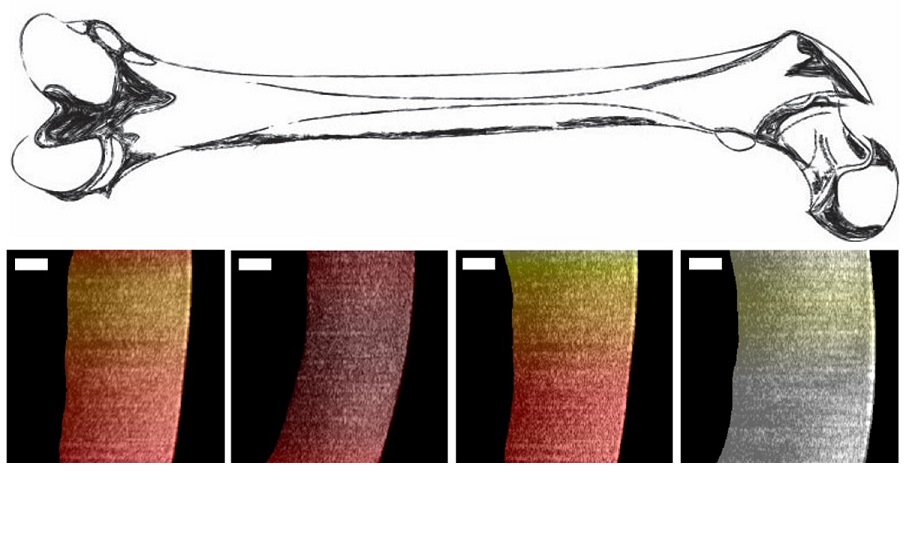About
12 November 2019
Low-Cost, Portable System Takes OCT Beyond Ophthalmology
Researchers adapt OCT system to make it useful for minimally invasive joint surgery
WASHINGTON — Researchers have developed a way to perform optical coherence tomography (OCT) in hard-to-reach areas of the body such as joints. The advance could help bring this high-resolution biomedical imaging technique to new surgical and medical applications.
OCT can image structures measured in microns, making it ideal for seeing subtle changes in tissue that might indicate disease or damage. Although OCT is now the standard of care in ophthalmology, making a high-quality OCT instrument compact enough for use inside the body has been challenging.

Caption: Researchers used a new endoscopic OCT system to visualize variances in pig cartilage thickness. The image shows a sketch of a femur and processed OCT images with thin regions shown in dark red and thicker regions more yellow and white. Scale bar is 250 microns.
Credit: Evan T. Jelly, Duke University
In The Optical Society (OSA) journal Optics Letters, researchers from Duke University report how they used a rigid borescope — essentially a thin tube of lenses — to deliver the infrared light necessary to perform OCT. Measuring just 4 millimeters in diameter, the borescope makes the beam delivery portion of the device very slim without sacrificing imaging performance.
“We saw a need for OCT image guidance in arthroscopic surgery, a minimally invasive procedure that uses an endoscope to address joint damage,” said research team leader Evan T. Jelly. “We took the low-cost OCT imaging platform we previously developed and adapted it to meet the requirements of this application.”
OCT through an endoscope
Working with Adam Wax, Jelly and their research team previously developed OCT systems that are a fraction of the cost of traditional models. To make an OCT system that could be used to assess the health of cartilage in a joint, they created an endoscopic delivery system that uses a prototype rigid borescope to relay the image from the tissue to a fiber optic connection. The instrument’s narrow front viewing section allows it to reach structures and cavities that aren’t accessible with the larger portion of the device that scans the patient.
The researchers designed the endoscopic OCT instrument to provide real-time quantitative information on cartilage thickness without requiring the doctor to cut or damage the tissue. This type of analysis is important for painful joint conditions such as osteoarthritis, which develop when cartilage wears down and becomes thinner.
The researchers tested their OCT instrument by using it to measure the thickness of cartilage in pig knees. Because pig cartilage is similar to that of humans, this provided a preliminary idea of how the device would perform in humans. The system was able to accurately identify the bone-cartilage interface for samples that were less than 1.1 millimeters thick.
With further development, the device could one day allow clinicians to offer less invasive treatment of joint problems. However, first the researchers must show that it can image thicker samples since human cartilage is slightly thicker than pig cartilage. They also want to further improve the ergonomics for use during surgery.
“By developing a new portable, low-cost version of OCT, we show that the success of this imaging approach will no longer be limited to ophthalmology applications,” said Jelly. “With some engineering expertise, this OCT platform can be adapted to fit a wide range of clinical needs.”
Paper: E. T. Jelly, Z. A. Steelman, A. Wax, “Optical coherence tomography through a rigid borescope applied to quantification of articular cartilage thickness in a porcine knee model,” Opt. Lett., 44, 22, 5590-5593 (2019).
DOI: https://doi.org/10.1364/OL.44.005590.
About The Optical Society
The Optical Society (OSA) is dedicated to promoting the generation, application, archiving, and dissemination of knowledge in optics and photonics worldwide. Founded in 1916, it is the leading organization for scientists, engineers, business professionals, students, and others interested in the science of light. OSA’s renowned publications, meetings, online resources, and in-person activities fuel discoveries, shape real-life applications and accelerate scientific, technical, and educational achievement.
About Optics Letters
Optics Letters has been publishing high-impact research in the field of photonics for over 45 years and offers rapid dissemination of new results in all areas of optical science with short, original, peer-reviewed communications. Optics Letters accepts papers that are noteworthy to a substantial part of the optics community. Published by Optica Publishing Group and led by Editor-in-Chief Miguel Alonso, Institut Fresnel, École Centrale de Marseille and Aix-Marseille Université, France, University of Rochester, USA. For more information, visit Optics Letters.
Media Contact
